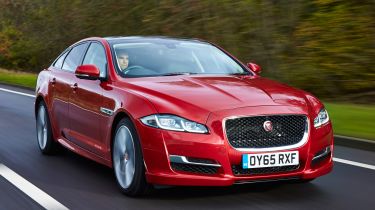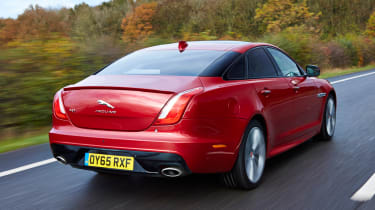Jaguar XJ review
With elegant styling and superb performance, the Jaguar XJ confidently rivals German luxury models

The Jaguar XJ is a worthy rival to the German luxury car trio of the Mercedes S-Class, BMW 7 Series and Audi A8 thanks to its dramatic styling, composed driving dynamics and high-class cabin.
The old Jaguar XJ was considered one of the most conservative looking luxury cars, but the current car has shaken off the Gentleman's Club image thanks to its classy looks and superb driving experience.
The speed of the Jaguar XJ, combined with its low driving position, wraparound cockpit, and sharp handling mean it's the best driver's car in its class. It creates the impression that you're driving a sports car, until you look behind and see how much space there is.
However, the nimble handling of the Jaguar is one thing, for passengers in the back, some comfort is sacrificed: even in the long wheelbase models rear headroom isn't as good as that found in the Mercedes or Audi.
When the current Jaguar XJ (code X351) arrived in 2010, the retro looks that we were used to with the old XJ were consigned to history. The car was the first one for sale that showcased Jaguar's latest design direction, and after almost a decade on sale, it still stands out in the limousine sector.
Used - available now

2022 Ford
S-Max Vignale
6,476 milesAutomaticPetrol2.5L
Cash £30,496
2021 Vauxhall
Astra Sports Tourer
41,054 milesManualPetrol1.2L
Cash £10,995
2017 Toyota
Yaris Hybrid
22,510 milesManualPetrol1.5L
Cash £11,104
2023 Ford
Focus Estate
19,162 milesManualPetrol1.0L
Cash £18,847It needed to be up to date to help it compete with its luxury car rivals. Chief among these is the Mercedes S-Class, closely followed by the Audi A8 and BMW 7 Series, while the Lexus LS is also worth considering. As the XJ offers decent driver involvement, then you might also want to consider the Porsche Panamera, which has a longer wheelbase in Executive spec, plus there's the Maserati Quattroporte while luxury SUVs like the Range Rover offer something different.
Revisions in 2018 saw the range trimmed back, with the biggest casualty being the supercharged Jaguar XJR performance model. The 5.0-litre V8-powered car is no longer part of the range, and in fact no current XJ is petrol powered. Instead, Jaguar's 3.0-litre V6 diesel is used, and it just comes in 296bhp guise, while all cars get an 8-speed auto gearbox and rear-wheel drive.
Short and long wheelbase variants are offered, with the latter commanding a premium of around £3,000 over the standard car. This gets you an extra 12.5 centimetres between the axles and an extra 12 centimetres of legroom, while most versions of the XJ can be had in SWB and LWB guises. The range currently comprises Luxury, Premium Luxury and Portfolio models which can be had in both lengths, while the R-Sport is SWB only and the plush Autobiography is LWB only.
• The best executive cars on sale
All cars feature a panoramic glass roof, LED headlamps, 14-way heated seats and four zone climate control, while more expensive models ramp up the kit count. Go for an Autobiography, and you can add rear tables and twin 10-inch JD screens, a 1,300 Watt audio system, massaging rear seats and a surround camera system with park assist, among other items. You do pay for it, although the XJ isn't quite as pricey as some rivals. You'll find the entry point to the range starts from around £63,000, but even the top-spec Autobiography is less than £85,000, and it comes with all of the kit you could ever want.
Jaguar XJ history
It's been more than 50 years since the original Jaguar XJ was launched. The Series 1 went on to be produced for 24 years in total, with major updates in 1973 and 1979 giving it an extended life. Originally it came with a straight-six engine that had originally been seen in the XK120 and E-Type sports cars, while Jaguar's famous V12 was fitted from 1972 onwards in the Series 2. Further refinements were made for the Series 3 that arrived in 1979, and this version remained on sale until 1992.
This overlapped with its replacement, the XJ40, which arrived in 1986, and this six-cylinder car and the older V12 model were sold side-by-side for a few years. In 1994 the X300-generation arrived, and along with it came the first XJR super saloon, which was also Jag's first supercharged road car. The X300 made way for the V8-powered X308 in 1997, which again featured a supercharged XJR variant. The all-new X350 version of the XJ arrived 2003 with aluminium construction, but it still retained the retro looks inspired by the original Series 1. These disappeared when the X350 was replaced by the current car in 2010.








